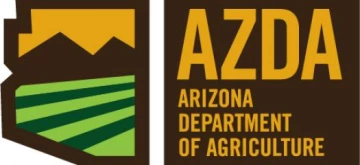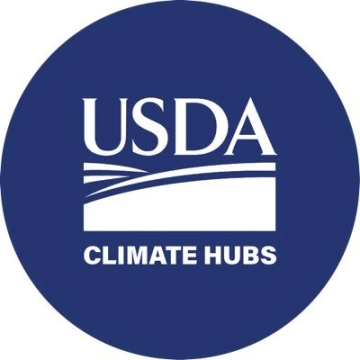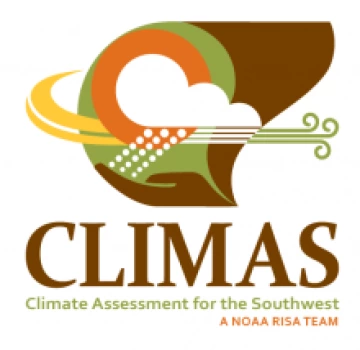< Back to Climate Viticulture Newsletter
Hello, everyone!
This is the October 2025 issue of the Climate Viticulture Newsletter – a quick look at some timely climate topics relevant to wine grape growing in Arizona.
IN THIS ISSUE
- A Recap of September Temperature and Precipitation
- The Outlook for October Temperature and Precipitation
- A Review of 2025 Ripening Conditions in Arizona AVAs
- Extra Notes
A Recap of September Temperature and Precipitation
Monthly average temperatures were within 2 °F of the 1991-2020 normal for most of Arizona (light blue, white, and light orange areas on map), including all three Arizona AVAs. For reference, monthly average temperatures in September last year were 2 to 5 °F above normal for most of the state. A few locations in the state escaped the near-record and record-level heat with near-normal temperatures.
Area-average maximum and minimum temperatures during September 2025 were 83.1 and 60.3 °F for the Sonoita AVA, 89.6 and 61.5 °F for the Verde Valley AVA, and 86.3 and 61.5 °F for the Willcox AVA. Respective September normals are 83.9 and 57.0 °F, 90.4 and 58.4 °F, and 87.8 and 58.3 °F.
Temperature last month ranged between 96.1 and 52.7 °F at the AZMet Bonita station, 93.6 and 50.5 °F at the AZMet Elgin station, and 97.0 and 53.1 °F at the AZMet Willcox Bench station.

Jeremy Weiss
Monthly precipitation totals were more than 125 % of normal for many extreme-western, central, east-central, and southeastern parts of the state (various aqua and blue areas on map), including all three Arizona AVAs. Many locations in south-central and north-central Arizona recorded near-normal totals (white areas on map), with some along the northern state border recording below-normal amounts (light yellow areas on map). Precipitation during September 2024 was less than 50 % of normal across all of Arizona.
Area-average total precipitation in September 2025 was 2.62 inches for the Sonoita AVA, 2.29 inches for the Verde Valley AVA, and 2.59 inches for the Willcox AVA. Respective September normals are 1.95, 1.53, and 1.40 inches.
Total precipitation last month was 1.89, 2.42, and 1.49 inches at the AZMet Bonita, Elgin, and Willcox Bench stations, respectively.
Dig further into daily weather summaries for the AZMet Bonita and Willcox Bench stations in the Willcox AVA and the AZMet Elgin station in the Sonoita AVA
Learn more about PRISM climate data
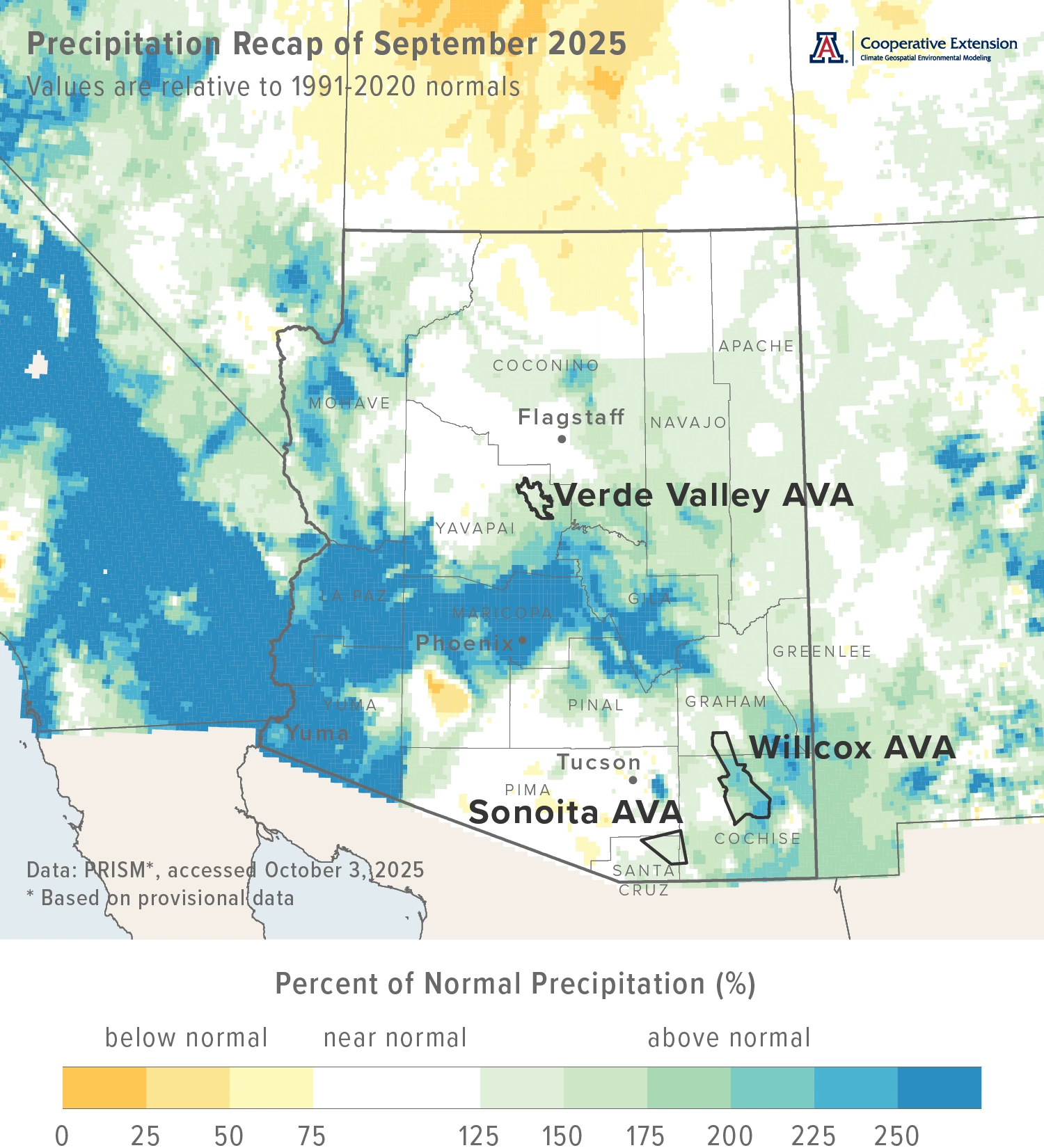
Jeremy Weiss
The Outlook for October Temperature and Precipitation
Temperatures over the course of this month have a slight increase in chances for being above the 1991-2020 normal across all of Arizona (light orange and orange areas on map). Monthly average temperatures in October last year were more than 5 °F above normal for almost all of the state.
Area-average maximum and minimum temperatures during October 2024 were 85.2 and 51.8 °F for the Sonoita AVA, 88.5 and 52.3 °F for the Verde Valley AVA, and 87.1 and 48.3 °F for the Willcox AVA. Respective October normals are 77.3 and 47.5 °F, 80.2 and 47.0 °F, and 79.9 and 46.8 °F.
Temperature in October last year ranged between 95.4 and 29.1 °F at the AZMet Bonita station and between 96.4 and 28.8 °F at the AZMet Willcox Bench station.
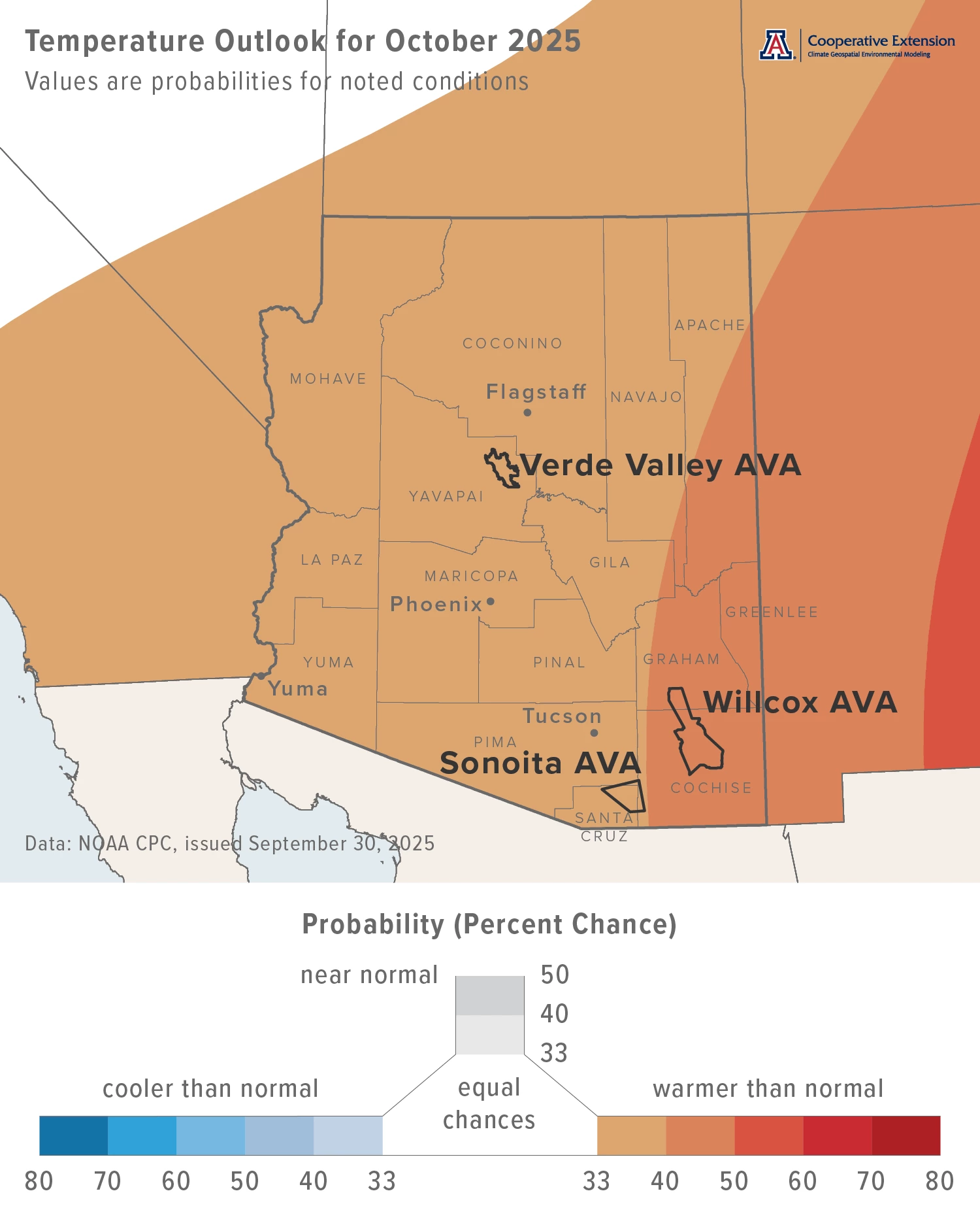
Jeremy Weiss
Precipitation totals for this month have a slight increase in chances for being below normal across extreme southeastern and east-central Arizona (light tan area on map). Otherwise across the state, there are equal chances for below-, near-, or above-normal totals (white area on map). Precipitation during October 2024 was less than 50 % of normal for much of the western one-third and southern two-thirds of the state. Only locations in northwestern Arizona recorded near- or above-normal totals.
Area-average precipitation totals in October 2024 were 0.00 inches for the Sonoita AVA, 0.41 inches for the Verde Valley AVA, and 0.02 inches for the Willcox AVA. Respective October normals are 0.95, 1.05, and 0.76 inches.
Total precipitation in October last year was 0.00 and 0.20 inches at the AZMet Bonita and Willcox Bench stations, respectively.
To stay informed of long-range temperature and precipitation possibilities beyond the coverage of a standard weather forecast, check in, too, with the six-to-ten-day outlook and eight-to-fourteen-day outlook issued daily by NOAA’s Climate Prediction Center.
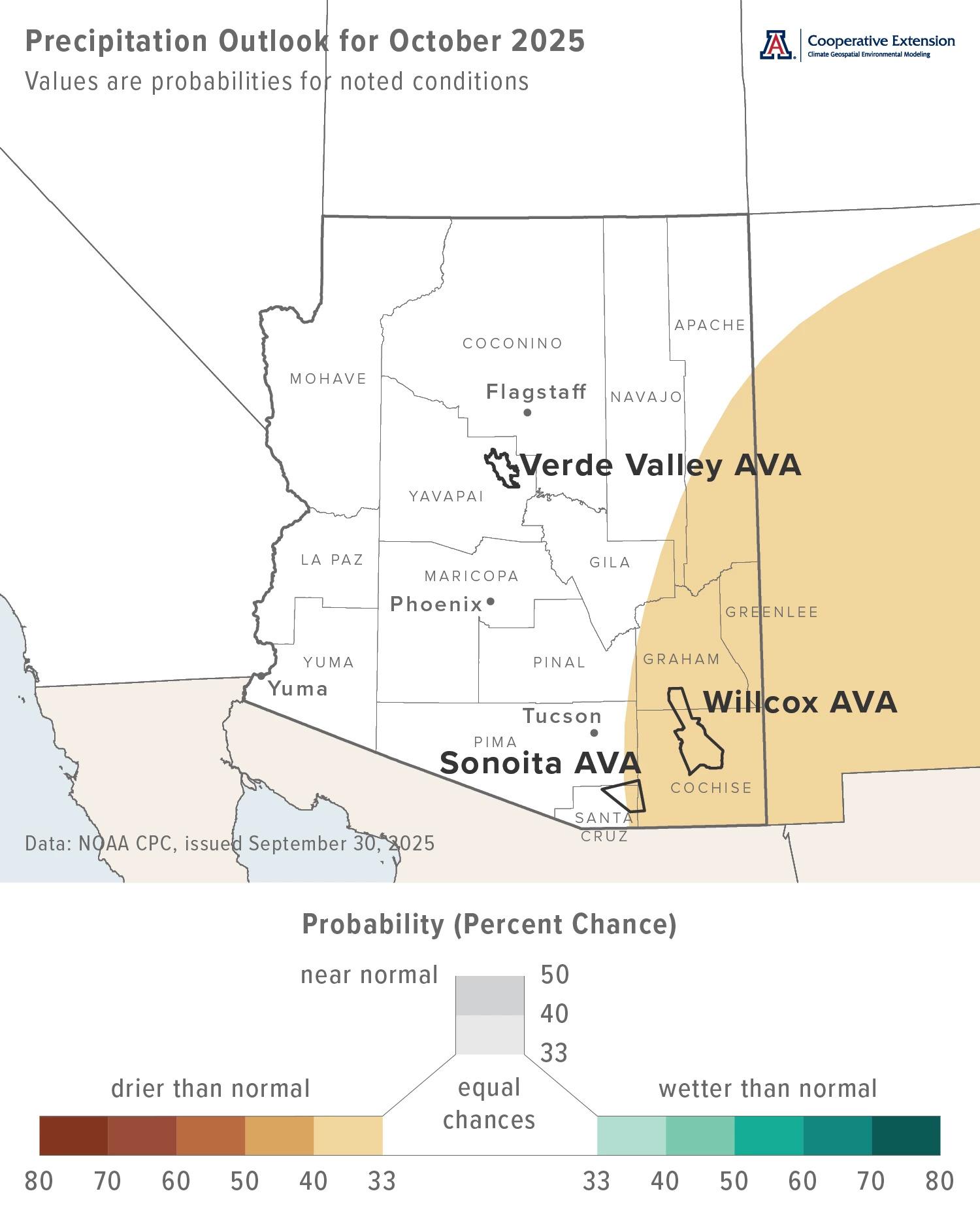
Jeremy Weiss
A Review of 2025 Ripening Conditions in Arizona AVAs
For this issue, we’ll take a different look at the conditions under which wine grapes ripen. Last month, the focus was on exposure to daily maximum temperatures above 95 °F and daily minimum temperatures below 65 °F. This month, the focus remains on the months of July, August, and September, when most varieties ripen in most locations during most years. The analysis, however, zooms out from daily details and summarizes seasonal temperature and precipitation from this year in comparison to prior ones. Why all the attention? Because temperature, precipitation, and humidity affect fruit quality and composition.
Compared to recent vintages, ripening conditions in 2025 are similar to those in 2024 for all three Arizona AVAs. This means that they are among the hotter and drier vintages over the past four-plus decades. Data in these graphs go back to 1981. Unlike recent vintages, however, conditions this year were not characterized by near-record to record heat nor near-record to record rainfall totals, whether dry or wet. To the extent that temperature and precipitation affect fruit composition, one might expect composition values this year to be similar to those from last year.
True to form, ripening conditions this year stratified among the three Arizona AVAs, more so with maximum temperature and precipitation (orange, purple, and green points in top graph) than minimum temperature and precipitation (orange, purple, and green points in bottom graph). That is, the Verde Valley AVA generally is warmer and drier than the Willcox AVA, which generally is warmer and drier than the Sonoita AVA. This may result in composition values that are relatively distinguishable among the state AVAs for a given variety.
Although we’ve written about this before, it bears repeating that the recent volatility in ripening conditions is in line with the expectation for a more variable and extreme summer climate both now and in the coming years. For Arizona viticulture, performance of varieties during these vintages may suggest what their role might be in monsoon hedging and may indicate their future viability.
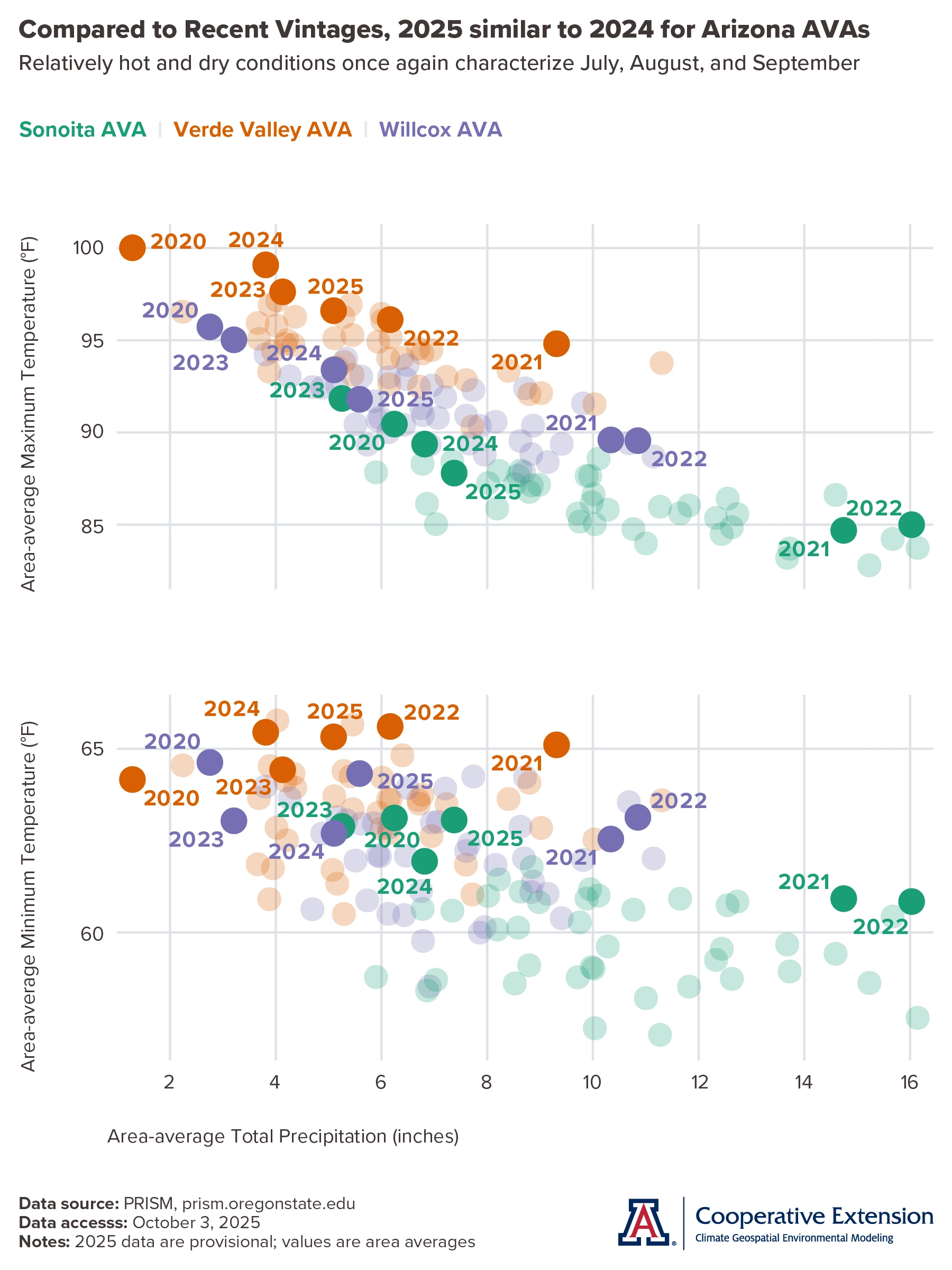
Jeremy Weiss
Extra Notes
The 2026 Arizona Wine Summit and Arizona Wine Growers Association Annual Meeting will take place January 11-13, 2026, at the Yavapai College Verde Valley campus in Clarkdale. Cost to attend is $100. Full registration details are coming soon.
Given recent and current conditions, there is a normal potential for significant wildland fires across all of Arizona in October, as based on the outlook from the National Interagency Fire Center.
Recent changes in oceanic and atmospheric conditions over the equatorial Pacific Ocean have tilted the forecast for September-through-November 2025 in favor of La Niña conditions developing, albeit with only a 56 % chance and expectations of being short lived. ENSO-neutral conditions are anticipated to return during the January-through-March 2026 period, with chances between 55 and 74 %. Notably, chances of El Niño conditions developing and increasing regional odds for winter precipitation remain below 10 % through the March-May 2026 period.
For those of you in southeastern Arizona, including the Sonoita and Willcox AVAs, Cooperative Extension manages an email listserv in coordination with the Tucson forecast office of the National Weather Service to provide information in the days leading up to agriculturally important events, like heavy rainfall from tropical storm remnants and early fall freezes. Please contact us if you'd like to sign up.
And for those of you in north-central and northeastern Arizona, including the Verde Valley AVA, Cooperative Extension also now manages an email listserv in coordination with the Flagstaff forecast office of the National Weather Service to provide similar information for this part of the state. Please contact us if you'd like to sign up.
Undergraduate students in the College of Agriculture and Life Sciences at the University of Arizona are looking for internships with businesses and companies in the viticulture and winery industries. Please contact Danielle Buhrow, Senior Academic Advisor and Graduate Program Coordinator in the Department of Agricultural and Resource Economics, for more information.
Please feel free to give us feedback on this issue of the Climate Viticulture Newsletter, suggestions on what to include more or less often, and ideas for new topics.
Did someone forward you this newsletter? Please contact us to subscribe.
Have a wonderful October!
With current and past support from:
